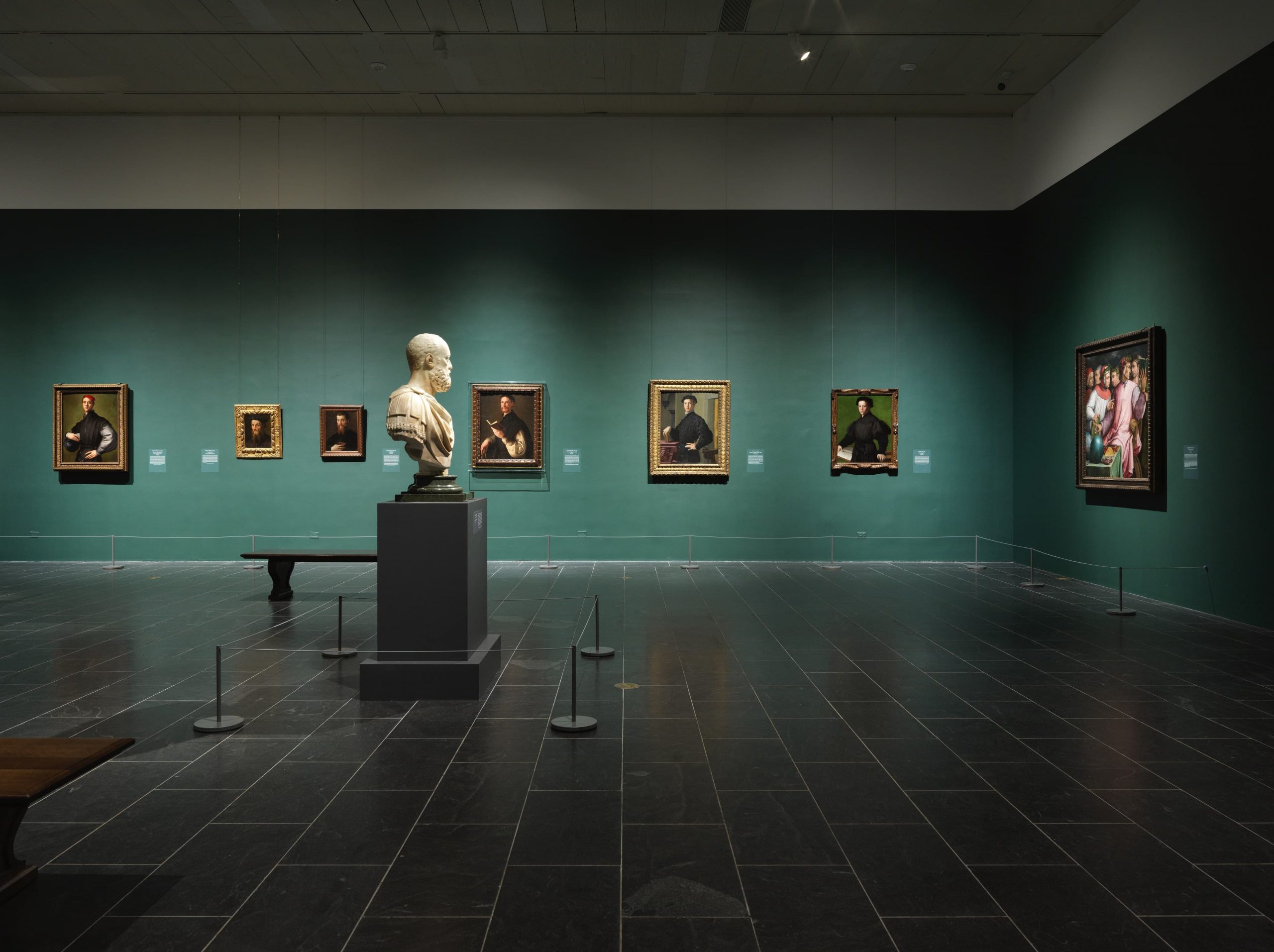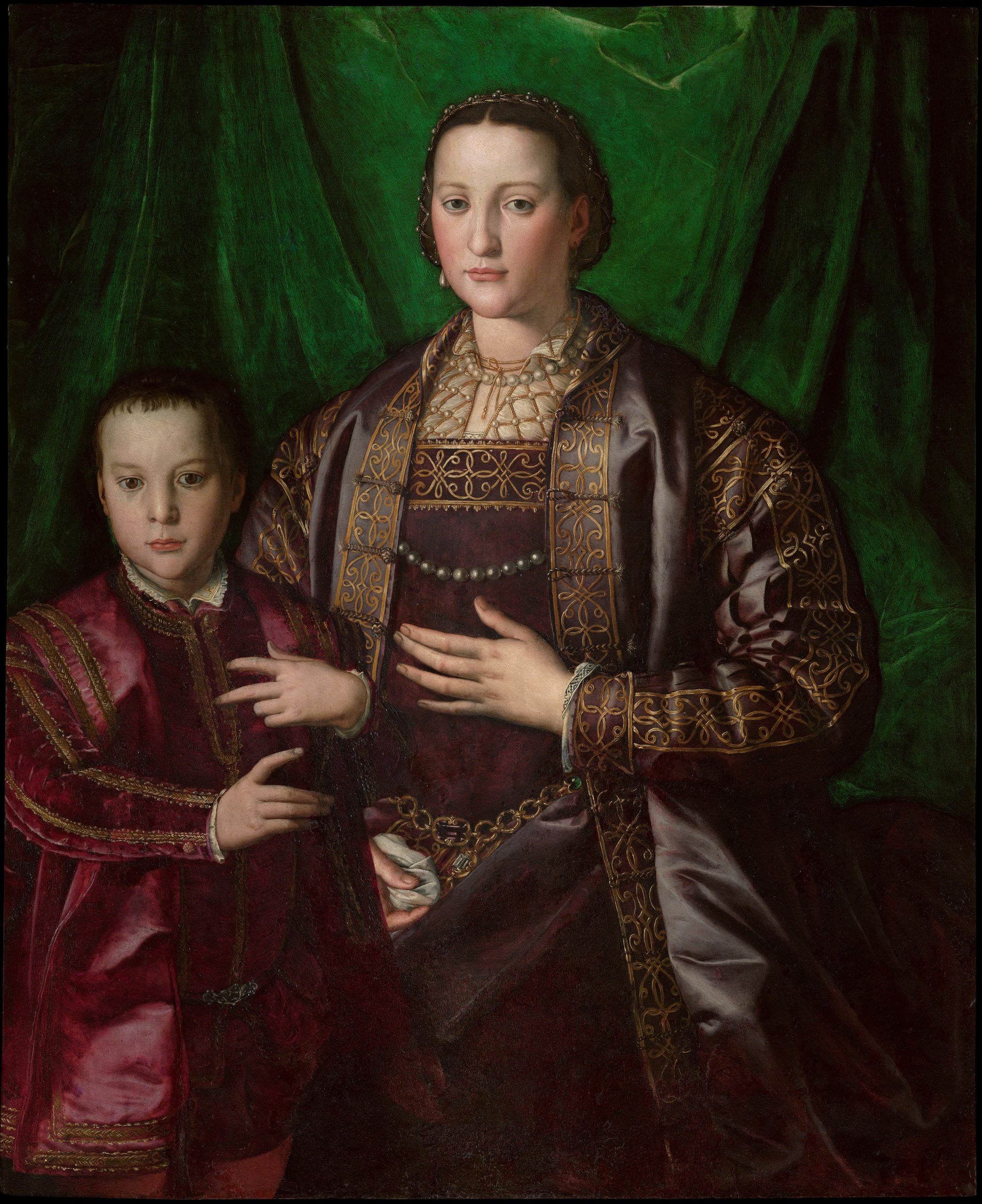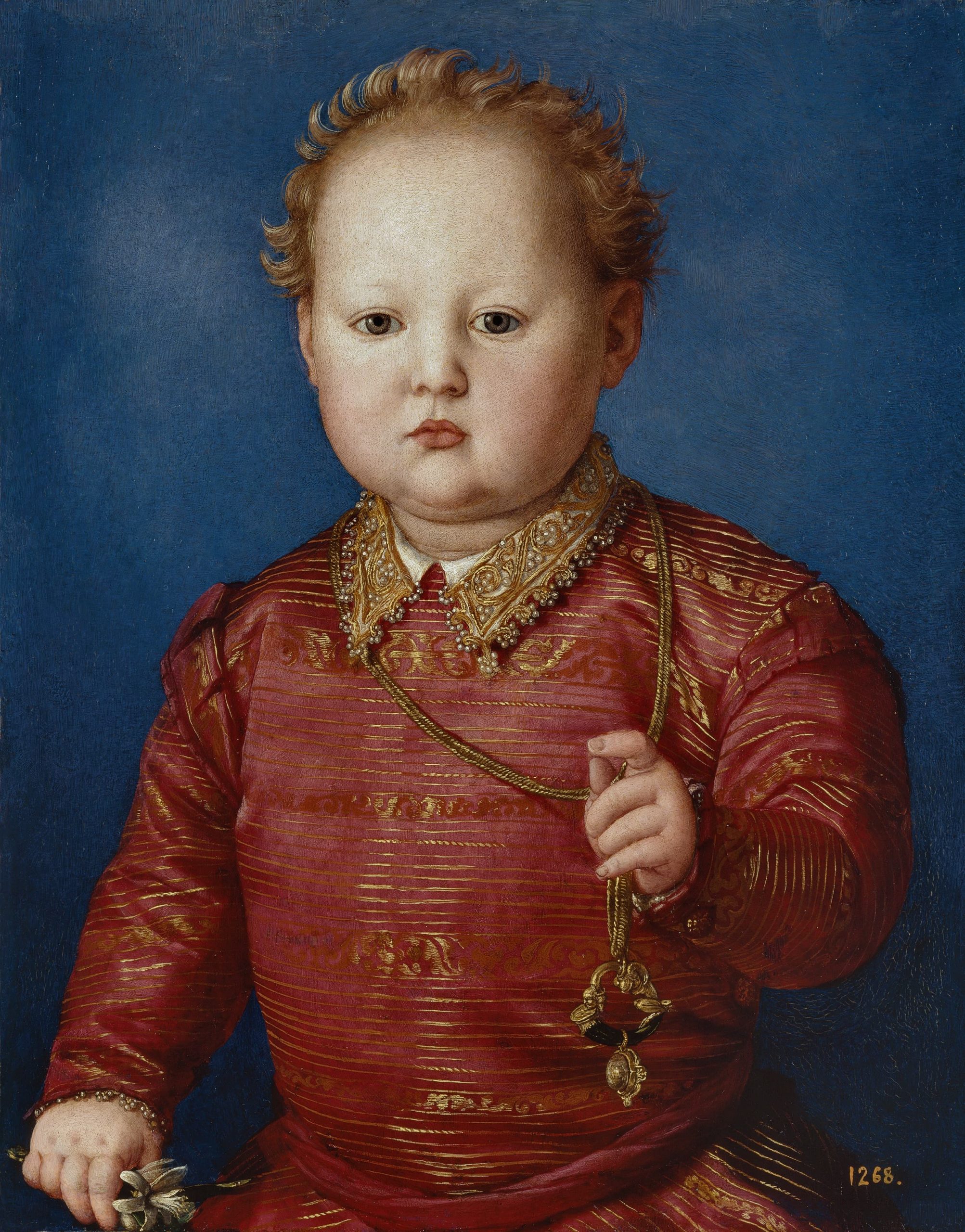Review of The Medici: Portraits & Politics, 1512-1570 The Metropolitan Museum of Art, The Met Fifth Avenue Through 11 October 2021
By Long Nguyen
In Transformative Medicean Portraits, Men’s Haute Couture Defined Ambition, Power, Identity, Class, and Pomp
The Medici oligarchy began in Florence with the establishment of the Medici Bank in 1397. Giovanni di Bicci de’ Medici (1360-1429) established a de facto hereditary and his son Cosimo di Giovanni de’ Medici (1389- 1464) to become the pater patriae of Florence, thus solidifying the banking and textile family into a political dynasty near absolutist rule in 1434. His great-great-grandson, Cosimo I (1519-1574), crowned himself the Grand Duchy of Tuscany upon the declaration of the Florentine state after the assassination of then ruler Alessandro de’ Medici in 1537.
After a period of upheavals in periods of republican government, Cosimo I consolidated his grip on aggrandizing local state power beyond the realm of just politics and economics. The new Grand Duke expanded the arts and literature reach in a formal state embrace and patronage of unprecedented proportions, championing the beacon of Renaissance art for grand architectural and artistic endeavors.
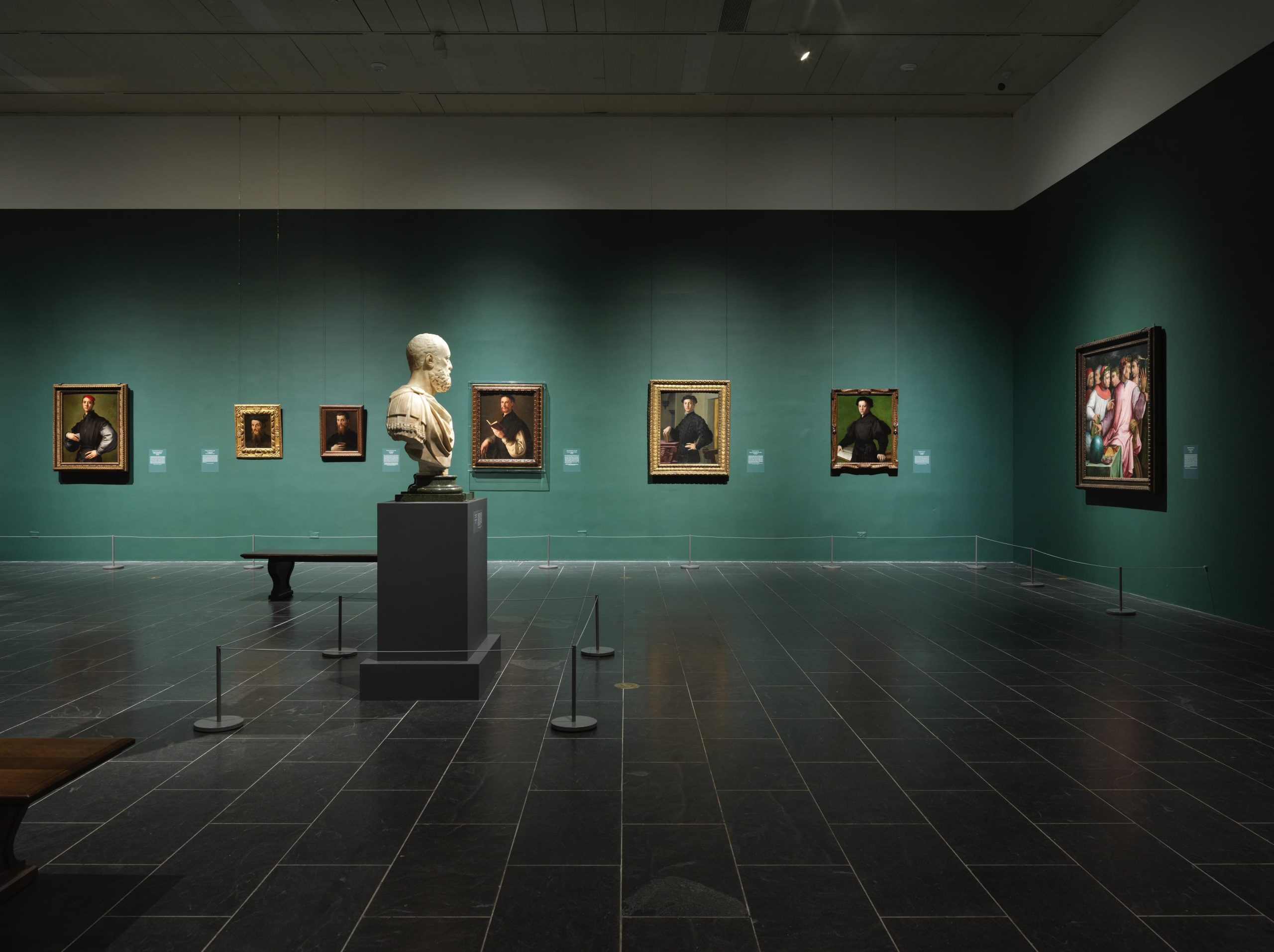
Under Cosimo I, this patronage of the arts accelerated as a principal tool to propagate the rule of the Duchy consolidated firmly as the seat of wealth, nobility, and power-centered Florence. The Medicean capital dotted with new architectural features, including the Uffizi Galleries, the Palazzo Pitti, the Boboli Gardens, and the Accademia delle Arti del Disegno in 1563 institute of Florentine art school. Galileo Galilei was, for example of Duke Cosimo I’s tutors.
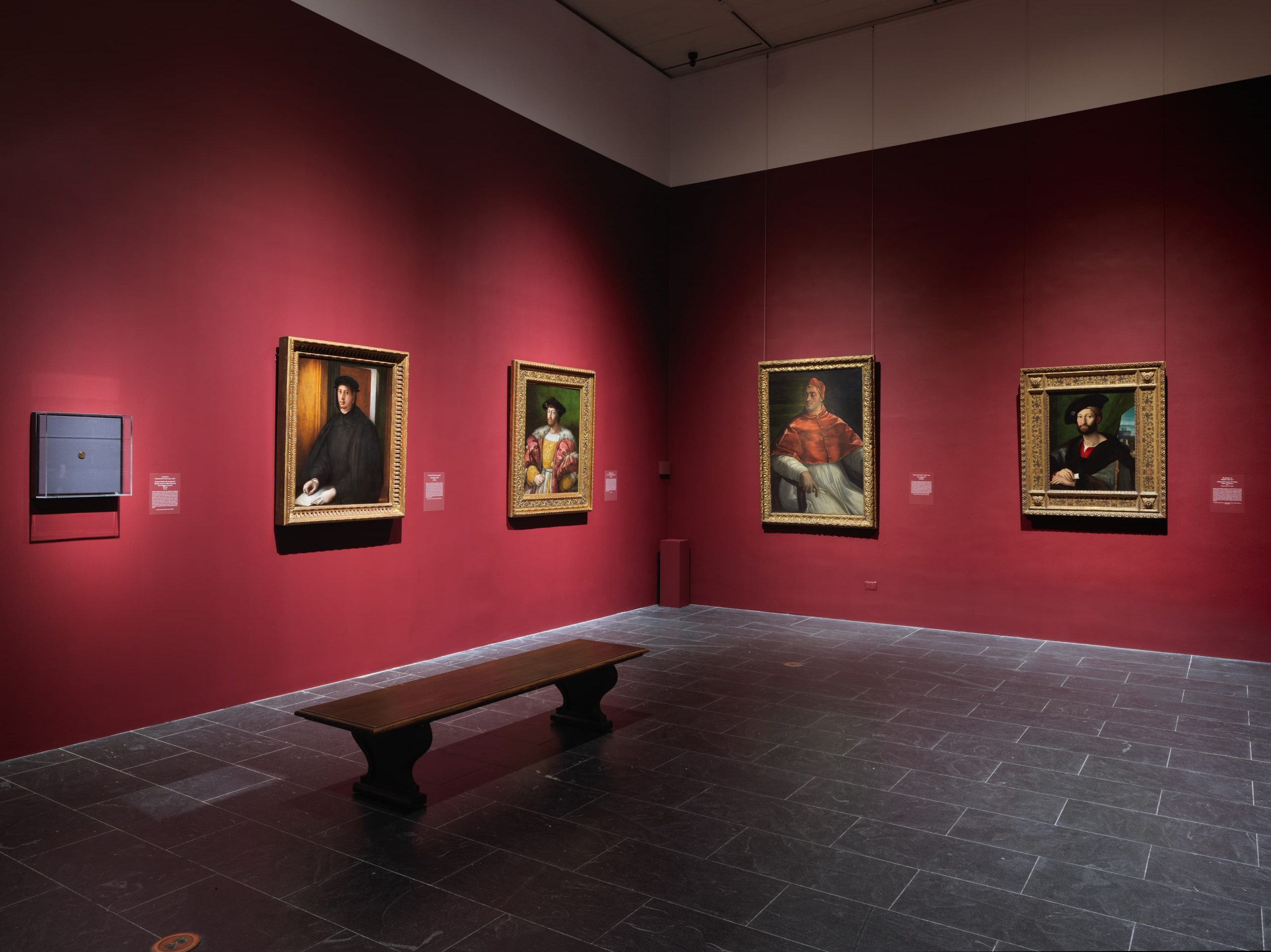
During Cosimo I’s reign, artists and writers such as Benvenuto Cellini and Baccio Bandinelli participated in creating a capital city thriving as a great cosmopolitan culture and art center. The painter Agnolo Bronzino (1503-1572) entered into Cosimo’s service in 1539 and he focused on the ducal family with his Mannerist style portraiture created in the center stage of this new thriving creative universe. In a nod to what could be called street credibility, today was Cosimo I’s deployment of the vernacular language of Dante, Petrarch, and Boccacio that led to the standardized Italian language.
Fashion was vital and central to the multifaceted significance in these Bronzino portraits, not just principal Medici figures but a range of Tuscan aristocracy as symbols of nobility that was the intended public image of the inherent power of the new ducal state. In this state, courtiers often imitated the styles of their sovereigns. Bronzino brilliantly combined the natural person, the artifice, and the myth merged in these composed and carefully orchestrated canvases where the sitter represented both enchantment and real-life authority.
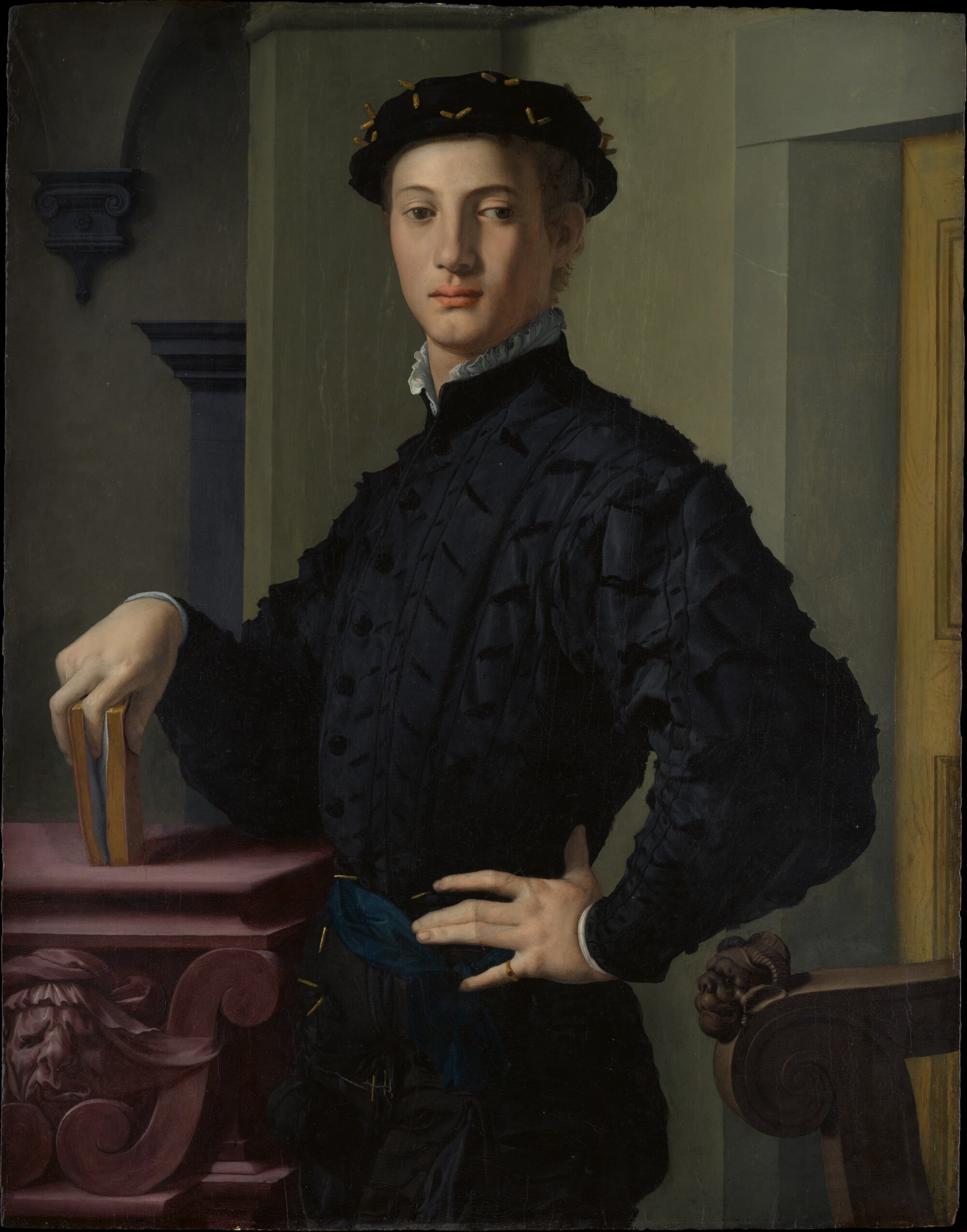
“Twenty three of Bronzino’s finest portraits, six by Pontormo, nine by Francesco Salviati and two bronzes busts by Cellini that rank among the greatest portraiture busts of the Renaissance,” said Keith Christiansen, the curator and the chairman of the John-Pope Hennessy Chairman of the Department of European Paintings of the concentration of ninety masterpieces in the ‘The Medici: Portraits and Politics, 1512-1570,’ exhibition. co-curators Carlo Falciani from the Accademia di Belle Arti in Florence. Christiansen underlined speaking at a preview before the opening that the collection is not about the Medici’s path to power but instead on the politics of culture in the service of this new absolute state.
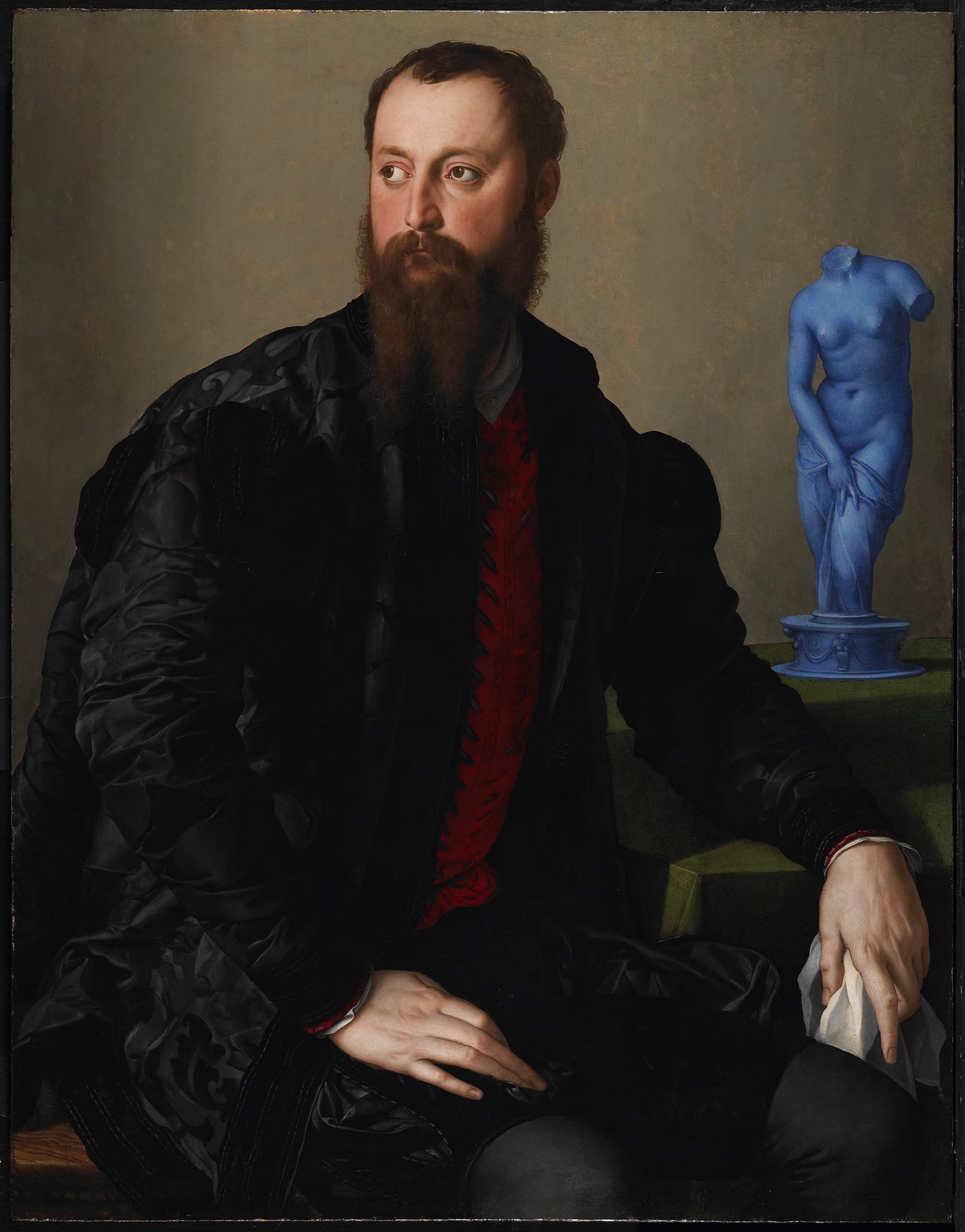
“At the very center of this transformation were questions of identity: a communal identity constructed around a common language and a shared cultural and intellectual heritage descended from the city’s republican past.” Christiansen mentioned the prime directive of the “poetic construction of an individual. Dress, metaphor, and allegory are used to allude to cultural interests, social status, and political affiliations.
“Portraiture provides perhaps the surest guide to an epoch and how people envisage themselves and the society in which they live. It provides a key that enables us to reflect on the women and men who entrusted their thoughts and their images to history through works of art that secured them some degree of immortality together with their aspirations and place in society,” Carlo Falciani, the co-curator of this exhibit. The Professor of Art from the Accademia di Belle Arti in Florence emphasized how these portraits were premeditated by their sitters as a principal way of creating an image of their identity and extend their power and authority in Florence and beyond.
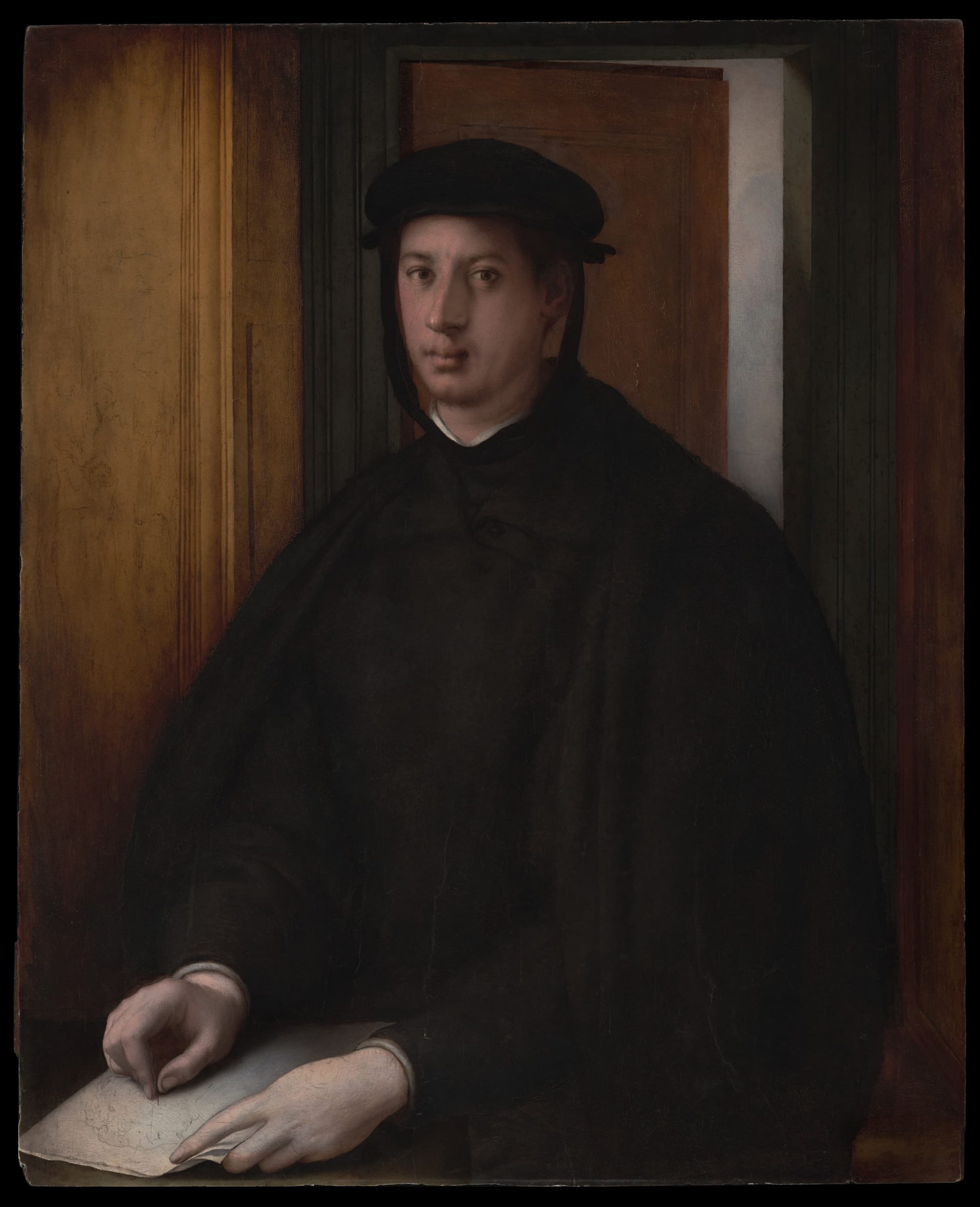
Duke Cosimo I’s marriage to Eleonora da Toledo in 1539, Emperor Charle V’s viceroy in Naples, ushered a new era for Florence. The new duchess brought the black clothes that were part of the Spanish influence on the occasion of her entry into Florence as a gesture to the passing of the relative Portuguese noblewoman. Clothes served to demonstrate and promote Duchy’s idea of politics, power, and pomp centered on the Duke himself as a prime political leader beyond the walls of the new city-state. At least for the Medici men in the Cosimo I era, Dynastic opulence was muted to communicate the seriousness of the men in power.
Fashion in the Cosimo I Duchy became a vital tool of personal identity and a vehicle of political and state regulations as pronounced in the 1546 sumptuary laws, one of the Duke’s first legislative orders. As the body developed into its powerful agency, these physical physiques became the principal focus of art, especially in the influential art of state-sponsored portraiture. Each figure of the Medici represents the identity of the individual and the state.
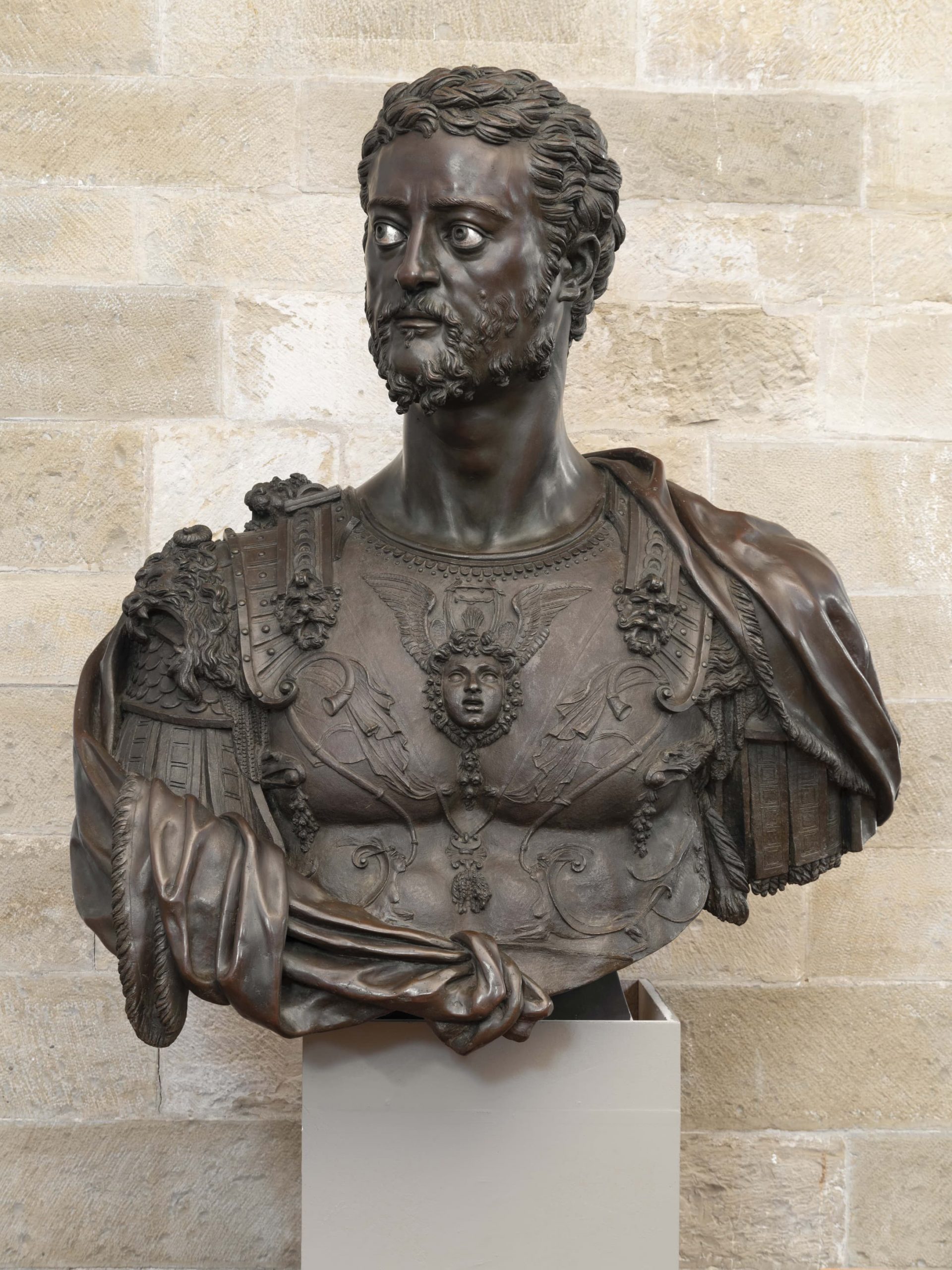
In the portraits on display at this Met exhibition, the silhouette and shape of men’s garments were lean. The fitted clothes emphasized the body of these Medici men as the locale of identity and authority. Besides their bodies, the fashion they wore conveyed the same message of utter confidence.
For the body to be a seat of power and authority, it has to link to mythology.
Bronzino’s depiction of Cosimo I as Orpheus painted around 1537-1539 at the start of the Duke’s reign offered the clearest example of expertly crafting the image of the new Duke as the legendary musician, poet, and prophet in Greek mythology, the son of the Thrace King Oeagrus and Calliope. Master musician or poet Cosimi I might not have been, but prophet he could have in his foresight in using art and culture instead of armies as the true power of his small state. Here, a grey bulldog stared at Cosimo-Orpheus, holding the wooden lyre in his hands. There was also Bronzino’s 1545 portrait of Cosimo in armor, his hand firmly placed on the steel helmet.
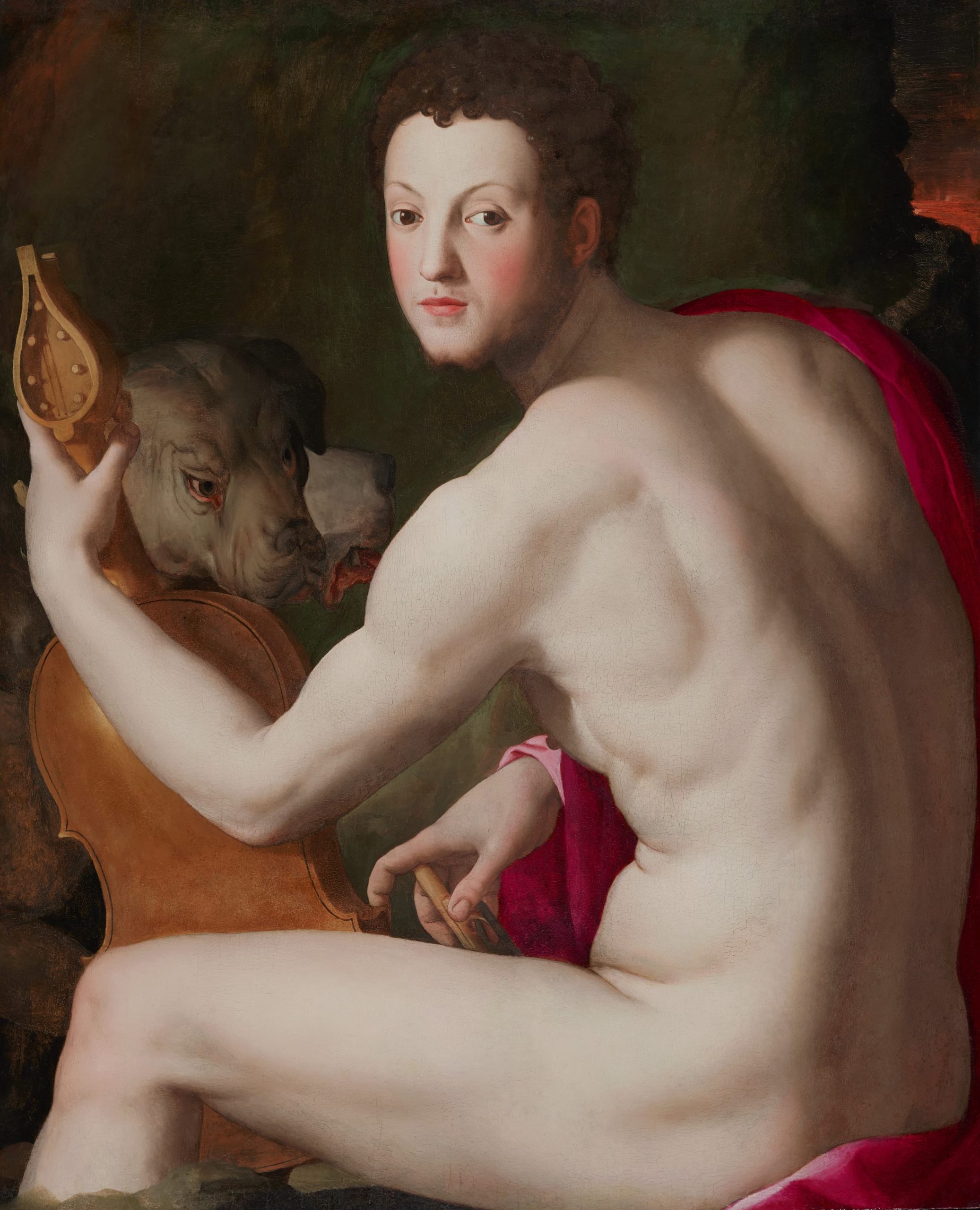
This tradition carried on two decades later in Bronzino’s 1560-1561 portrait of Cosimo I’s son Giovanni de’Medici as Saint John the Baptist – the ascetic Jewish prophet as the forerunner of Jesus, nude with a purple, blue stash of fabric across the bottom of his legs. Both father and son stared straight into the eyes of the audience, looking at them as an acknowledgment of this moment of transcendent, portrayed as mythological figures wrapped in narrative legends rather than sartorial vestments.

In the Cosimo I era, the color of men’s fashion shifted towards darker hues and more subtle decorations, signaling a turn away from exterior decorations that might have interfered in the seriousness that clothing now played in the image construction of the person, albeit politicians.
Raphael painted the 1518 portrait of Lorenzo de’Medici, then Duke of Urbino, served as a juncture between the tumultuous times in the decades before Cosimi I came to power. Lorenzo wore a sumptuous red silk brocade puffy sleeve coat with fur collar over a yellow velvet floral motif tunic jacket with a mixture of white, light grey, and gold silk trim panels and a black hat with insignia emblem. The lavish form of the coat in opulent red silk with shiny gold threads capped by the sizeable furry collar took up most of the space in this near-meter-high portrait. This outfit overshadowed the sitter, whose face was minuscule and occupied a background status contrast to the overwhelming presence of the magnificent haute couture look. This sumptuous and colorful style soon was out of favor as the Duchy established itself in 1537.
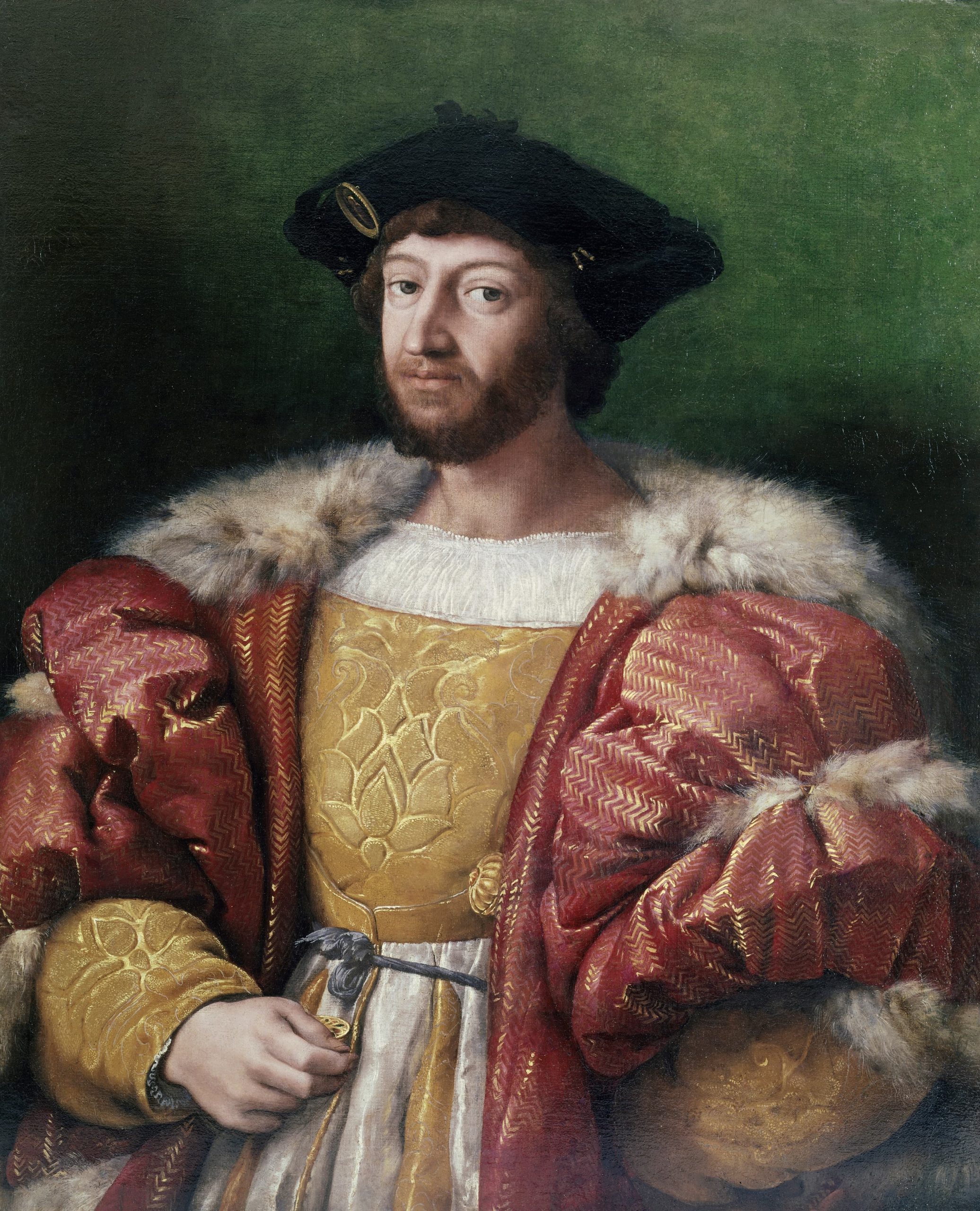
Male dress in these portraits at the Met placed slightly less emphasis on excessive decorations. It shifted away from the more colorful red, blue, gold, pink, and green-hued tunics of the previous decades, with rising hemlines showing off the multi-colored stockings to denote particular allegiance and loyalty to specific houses and ruling cliques. Fashion at the top had a downward scenographic on the clothes of the courtiers and the wealthy elite.
The male dress fitted into the framework of the new portraiture to convey a visual concept and not just a painted image of the sitter. The fashion fabrics of choice for the Medici revealed in these portraits were velvet, silk, and satin, at times decorated with slashes, small embroideries, and small trimmings with decorative bands. However, these embellishments were always subtle, adding depth to the painting and not outlandish adornments on the surfaces of these painted clothes.
Two types of male dress were dominant during this era of the mid-1540s, centered on the styles associated with the republic and those in line with more aristocratic living standards under the Medici grand dukes. The Florentine traditional long cloak called the lucco was a garment of simple construct – ankle-length opened at front and side in black wool or lined with fur, velvet, or damask surrendered to the shorter outwear version more streamlined what would be a precursor to a modern-day power pantsuit.
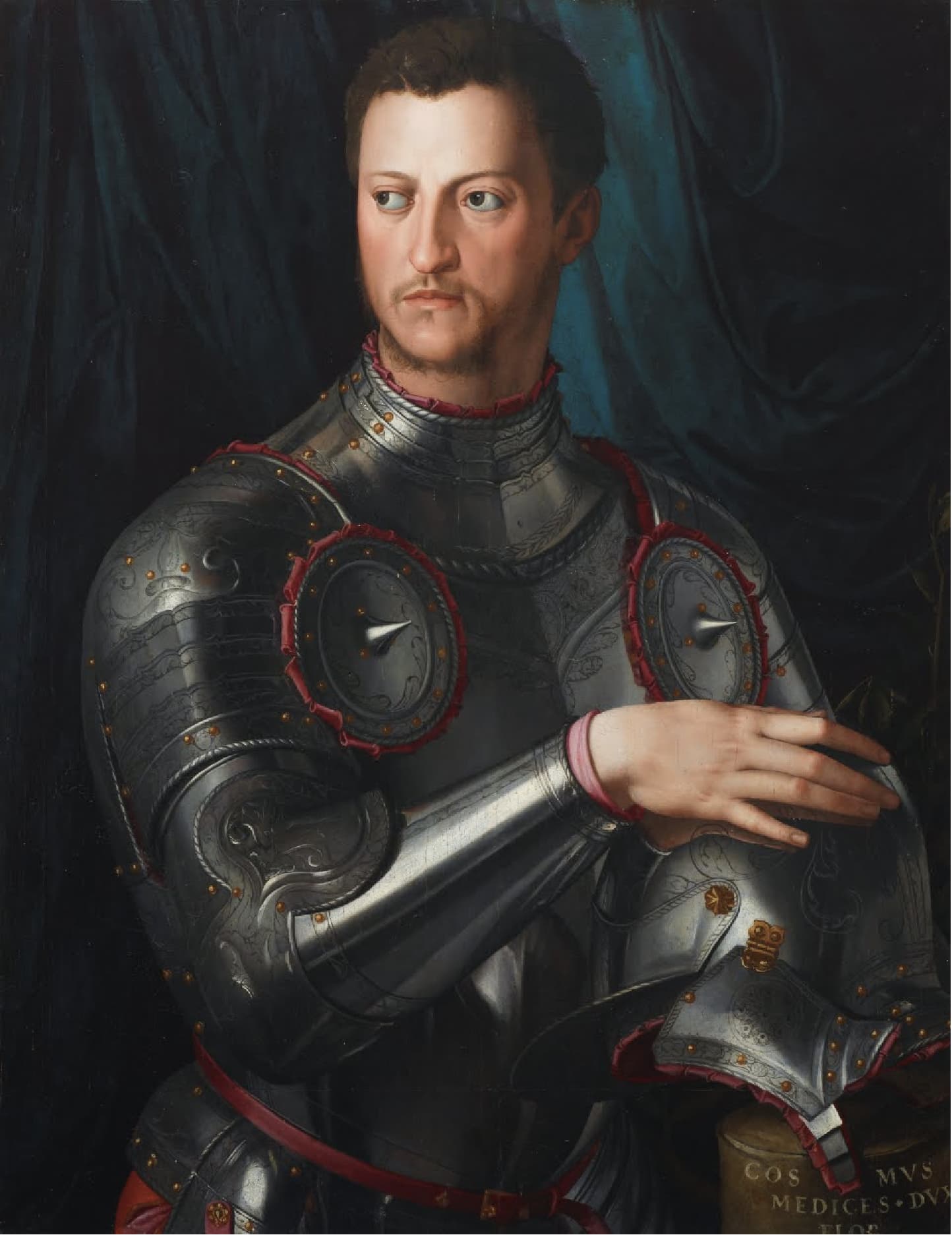
In the portraits, the male jackets or outer coats, tunics, and stockings were mainly black velvets and silks with a degree of shine surface to reflect the depth of the elaborate fold construction giving a three-dimensional feel rather than a flat fabric surface. Jacopo da Pontormo’s portrait of Alessandro de’Medici painted around 1534-1535 showed the Florentine republic’s Duke as a stern and serious ruler. In a black outer coat draping on top of a black spread collar jacket tunic and a tiny peek of a white shirt underneath coming above the collar and at the sleeves.
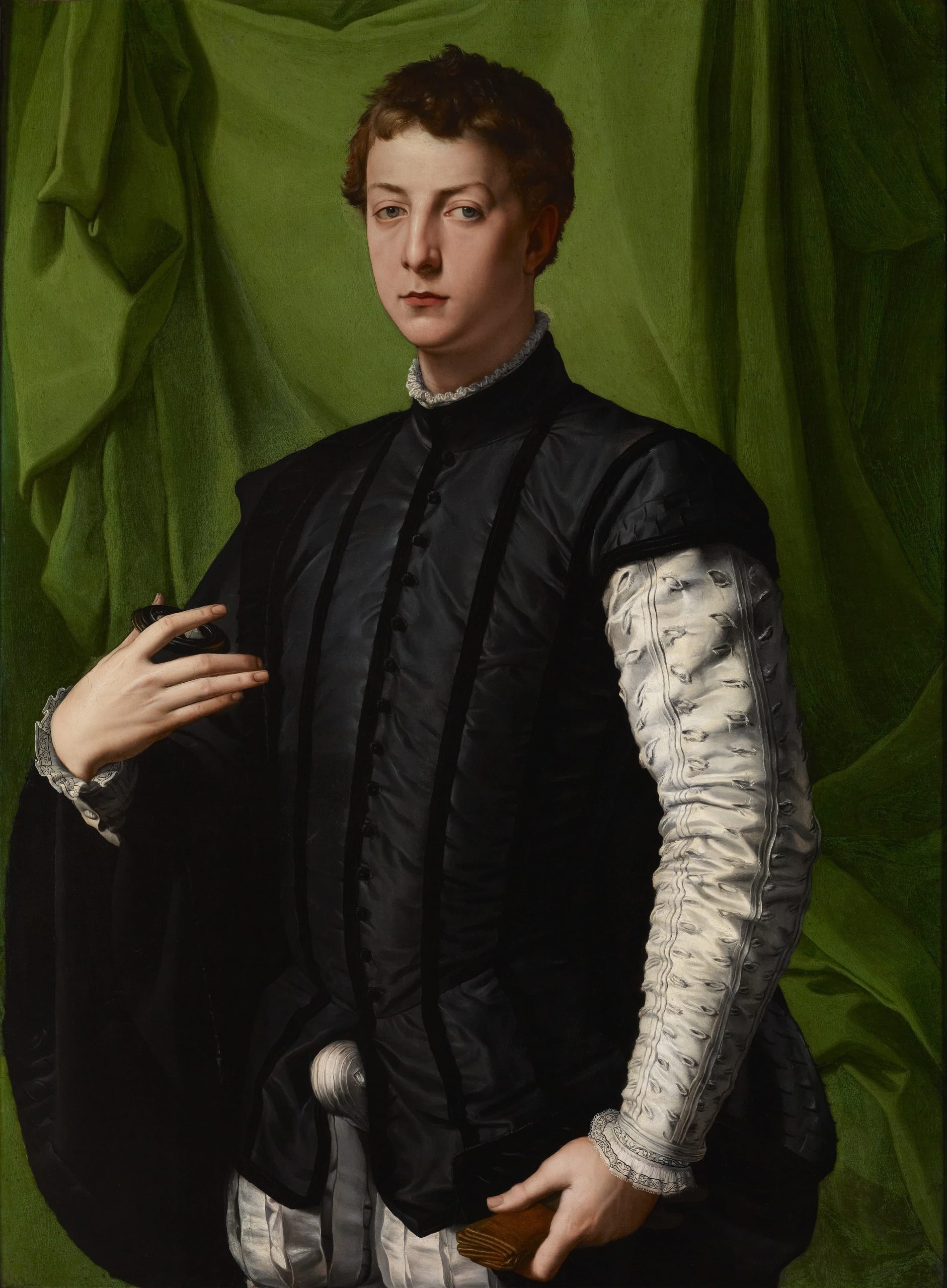
Draping the cape-coat over his shoulders was not an arbitrary act. Alessandro de’Medici telegraphed the notion that he had absorbed the officialdom of the long coat from the previous generation of politicians but that the Duke had added his garments of a tunic-jacket that represented the new way of power dressing. The old order and the new regime rested on this combination of the outerwear-cape and the tunic-jacket. On his head was a plain black velvet hat, an accessory that telegraphed the new age of greater austerity in Florentine men’s high fashion where the clothes bound together with the court and culture.
Perhaps the most powerful portrait in this entire show across the masterpieces remains Agnolo Bronzino’s Portrait of a Young Man with a Book painted in the 1530s. The sitter in question, possibly a literary friend of the painter who was also a poet. He posed elegantly in a pose full of self-possession and arrogance – his left hand grasping his hips and his right hand with three fingers holding open pages of a book perpendicularly.
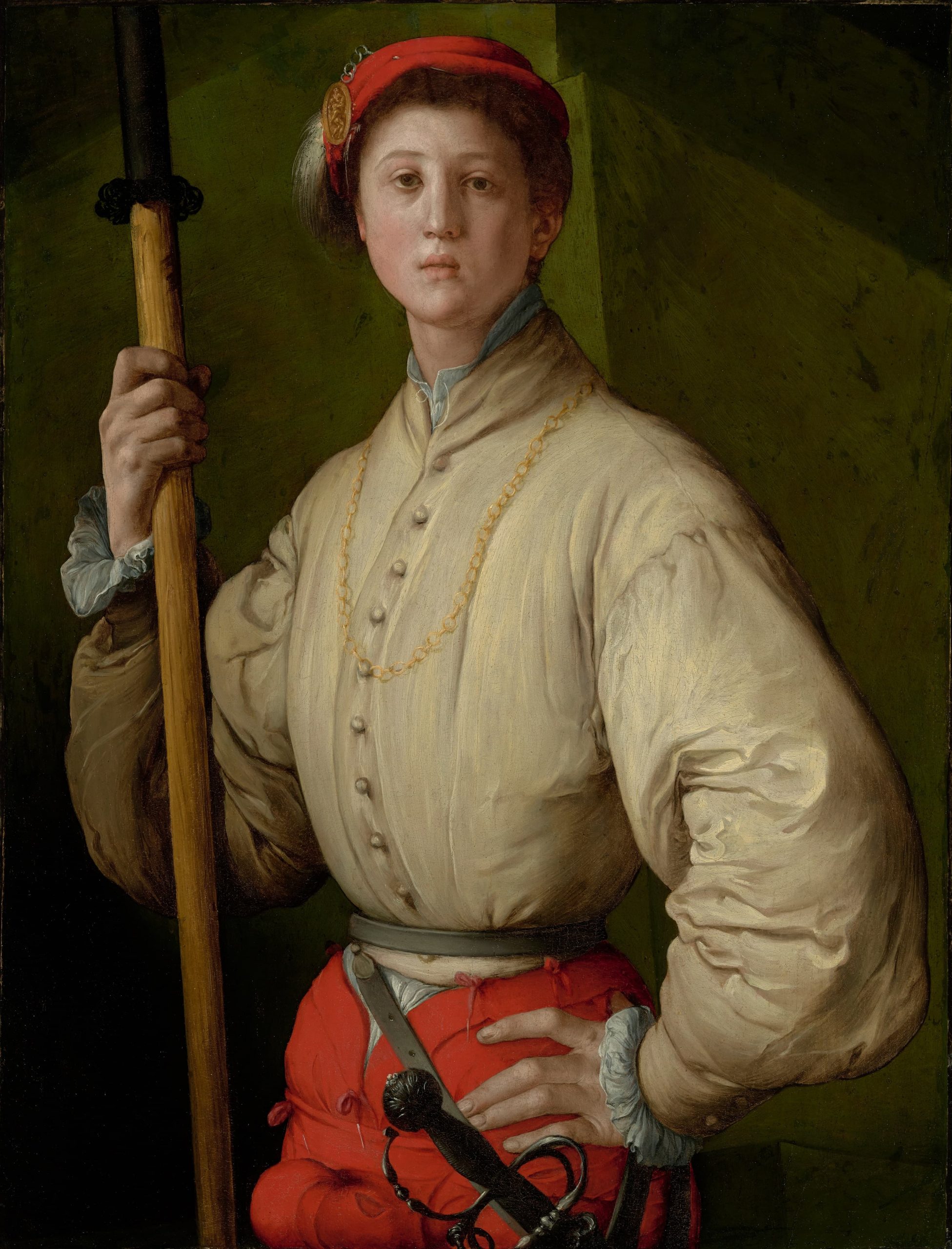
This young man wore a black, very fitted doublet or guibbone – the power jacket of the Cosimo I court – probably in light velvet with the fabric folded and slashed at specific angles to create a depth of a 3D effect in real life and painting. Bronzino painted with great details the small fringes from this slashing technique with clarity on the dominant left arm, where the fringes are visible on the shoulder bones and along the arm’s length. The slashes run in a zig-zag pattern on the sleeves and body of the tunic jacket enhanced the effect of depth on the fabric. The doublet had center buttoning running straight down the torso and a light elevated collar showing a ruffle collar of the light grey shirt underneath.
This particular Bronzino portrait of a non-Medici man represented the extent to which the fashion worn by the Duke and those close to him had a real impact on how others in this society also adopted the Medici’s taste.
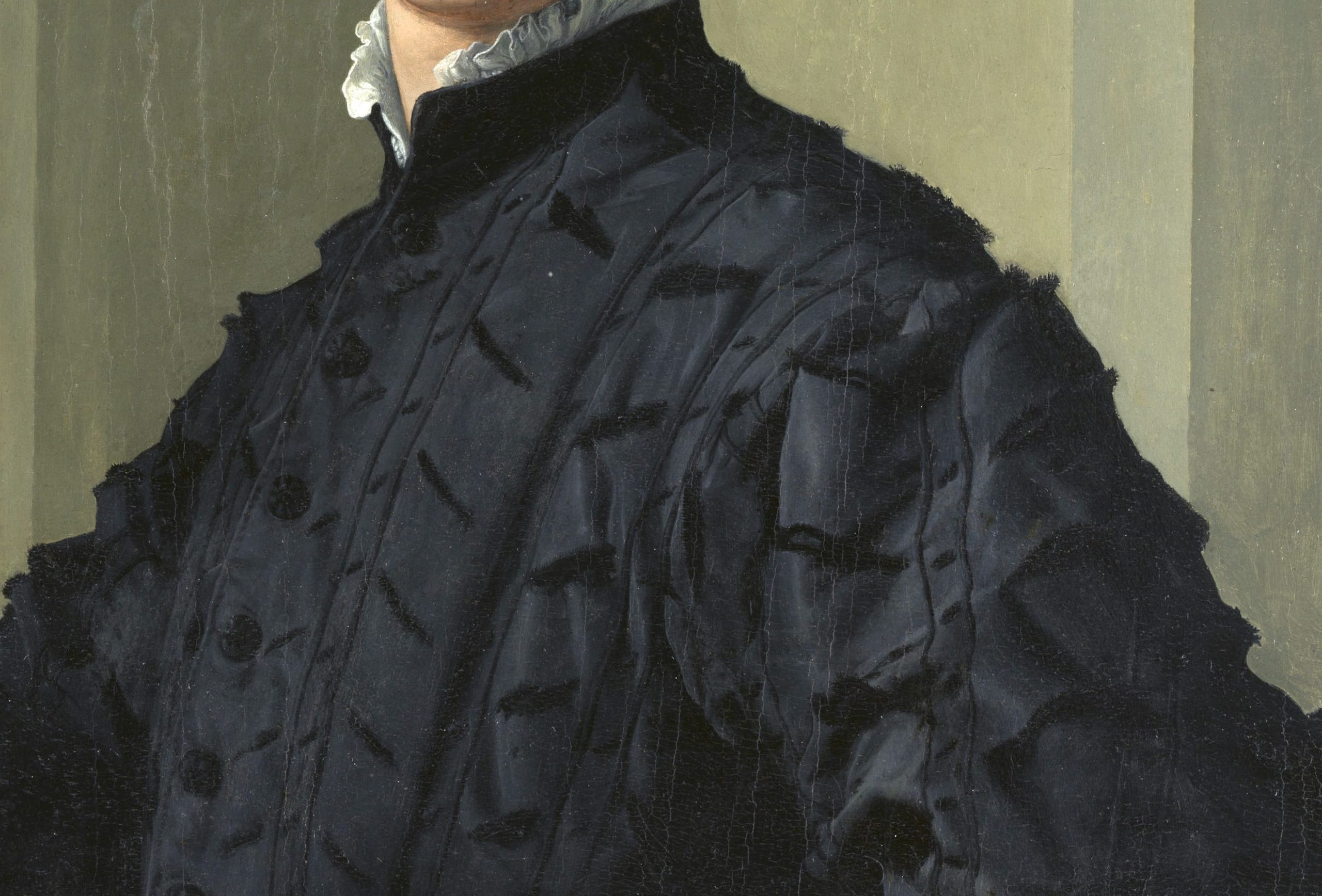
The slash, the unique weaving of the satin silk, and the folding techniques on constructions were the new adornment methods replacing the showy decorations like significant embroidery or other ornamentations to stay in line with a more standardize idea of sober elegance and somber hues under Cosimo I.
Like the 3D effect of the slashed doublet with holes and fringe trims in ‘Portrait of a Young Man with a Book,’ Bronzino’s Portrait of a Man circa 1550-1555 allowed the slim shape irregular surface structure of the black satin pattern open doublet, with matching short pants, black hose and the elaborate lacing of the red shirt underneath with a short black matching the doublet and a pair of shiny black hose. The sharp cut of the streamlined black outer coat is tight and fitted to allow the second layer of a shirt to peek out very slightly under the grip of the sleeves and just out of the neckline.
These cut slashes and deliberate fabric folds became the new forms of embroideries and embellishments. These lean doublets used far fewer fabrics and less labor to make. Thus their provenance aided the dominant sober Florentine fashion where the excess of furs, feathers, and embroideries were no longer accepted norms.
Painted in 1529-1530, Jacopo Pontormo’s Portrait of a Halberdier drew the line on the change in the abandonment of colors in male fashion instituted under Cosimo I. The real identity of the young soldier remained unknown, though suggested to be either the young nobleman Francesco Guardi or even possibly a young Cosimo I himself. The youth wore a light camel yellow silk doublet with front buttoning, puffy sleeves, pale grey shirt, and red breeches with a leather belt. His right hand firmly held a halberd, a combination of spear and ax, but his eyes looking straightforward revealed a bit of uncertainty. The doublet here is the same in shape and cut as the black slashed doublet version worn in Bronzino’s Portrait of a Young Man with a Book painted in the mid-1530s. The red wool hat here is decorated with a military logo, while the black velvet hat has some attached feathers.
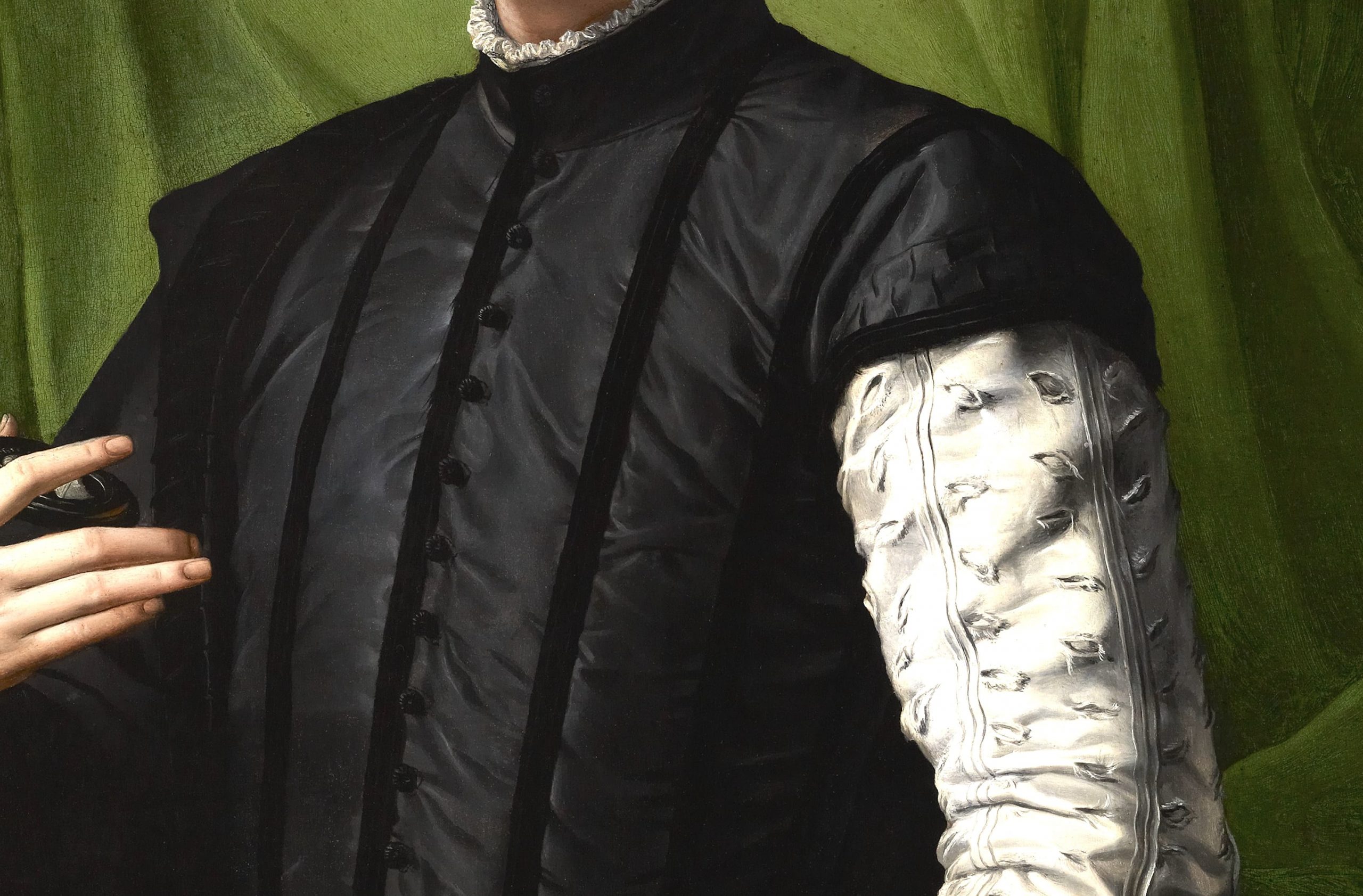
Detail of Bronzino (Agnolo di Cosimo di Mariano), Italian, Monticelli 1503–1572 Florence. Lodovico Capponi, 1550–55. Oil on wood, The Frick Collection. 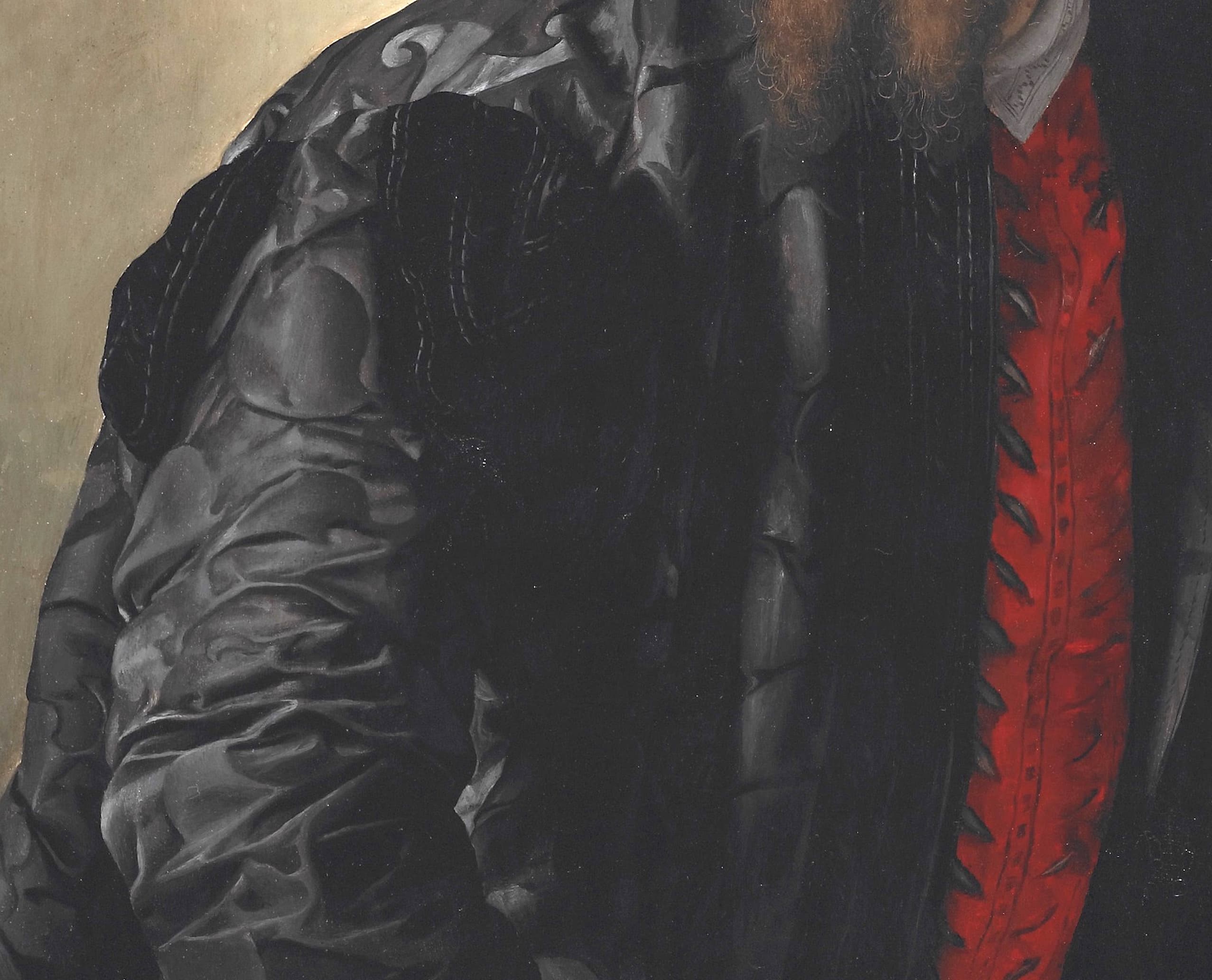
Details of Bronzino (Agnolo di Cosimo di Mariano),
Italian, Monticelli 1503–1572 Florence. Portrait of a Man (probably Pierantonio Bandini) ca. 1550–1555. Oil on wood. National Gallery of Canada, Ottawa.
Lodovico Capponi, portrayed by Bronzino in around mid-1550 as a young man of between 17 and 20 years old from a very wealthy textile merchant, demonstrated the simple power of clothes dressed sumptuously in a black silk taffeta sleeveless cloak coat with black velvet stripes and a codpiece, a white satin slash shirt, and a white satin trunk hose. In the young Capponi outfit, the color black and white were the colors of the family color coat of arms. In this painting, a similar garment to what Lovovico Capponi wore was the red satin and velvet court suit – a doublet with front buttons and paned trunk hose – restored from the Medici tomb from Don Garcia de’Medici.
For menswear, there was a specific order in the portraits from undergarments to outerwear. The first layer was a camicia (shirt), then farsetto (doublet) quilted for shape and chest definition. Over this undergarment was a tunic on top of the farsetto, such as the shorter giubba (blouson) and villano or the longer cioppa and wool lucco full-length cloak. The liveries of the Medici courtiers served to reflect the portrait’s sitter, not just the distinct cultural and social identity. It was also a period of significant social change and class fluidity. Still, fashion wasn’t much of a gendered phenomenon, meaning more cross-overs of male and female sartorial structures such as similarities in the cut of garments and sleeves’ shapes, for example.
The shorter thigh-length, slightly circular coat – the cappe, ferraili, or tabarri – replaced the long cloak outerwear favored during the republican era with an aura of military garments. For Cosimo I, these shorter-length coats offered greater mobility. Still, the lucco provided a link to the past. His government made this lucco an official garment in the 1546 and 1562 laws, albeit with some exemptions and a degree of hierarchical differences. This long cloak and its varieties showed the apparent maneuvers by the ducal regime to control fashion to its courtiers and citizens. Wearing the lucco was, in essence, a manner of social and political affirmation.
Fashion was a principal means for Cosimo I to project the Florentine identity to both insiders and outsiders by coupling traditions with new materials made locally, enriching the city-state, and highlighting the quality and the uniqueness of the Grand Duchy. The idea of moderate clothing under the republican state lingered on clothes with wool or silk textiles gained with the wealthy merchant and nobility class with a vested interest in local textile businesses.
In a way, Cosimo I consolidated his authority on the back of slightly modifying the lucco, the traditional long cloak of the republican epoch, perpetuating the aesthetic ideal of the recent past to strengthen his grip on power. Despite having been blessed legally as a holdover garment from the republican era, the lucco was not, in essence, fashionable enough for aristocratic Florentine.
Cosimo I created his first sumptuary legislation in 1546 – Riforma sopra il vestire – with other legislations in 1562 and 1568 to develop and promote the full harmonious fashion image in Florence. These laws controlled the fashion that his courtiers and the men in the family were to dress – modest elegance, not any vestments considered too decorated. While attempting to regulate the dress of Florentines to prevent excess spending, the laws provided many exemptions for those with noble titles from the total confines of prudence in support of the Florentine aristocratic society.
Sumptuary laws covered a wide range of practices aside from men’s and women’s clothing to the regulations on funeral, baptism, and importation of fabrics, for example, to protect the local silk and fabric producers. But, the real impact of these cascades of restrictions also provided avenues to evade their stringencies by inventing other forms of fashion as responses to circumventing the sumptuary laws governing style.
Sought to downplay excessive use of materials and ornamentations rather than restricting a particular style of dress, at times sumptuary laws were protectionist, preserving local fabrics made in Florence and Venice instead of primarily aiming at tempering extravagant expenditures to in clothes and accessories.
“A gentleman can be made with two yards of real cloth” was a common saying attributed to Cosimo I. The image of any individual dictated social, economic, financial, and reputational status in this appearance-obsessed environment. The rise of court culture under the Medici specified and enhanced the importance of projecting these images in public to be seen by others. The portraits in this Met show confirmed how the identity of the Medici deployed fashion to portray themselves as leaders of the social-political order as viewed and internalized by Florentine society and beyond. The clothes painted in these portraits were the first visuals of the new power suits of their days.
Despite its aim at modesty, the laws allowed, for example, the use of pearls showing off an expanded and wealthier society. Marquis, counts, and other titled men were exempted from these legislative maneuvers to preserve and project the image of the luxury court of the Medici ducal rule. Social class and gender dictated the kinds of fashion worn. Thus, laws limit the choice of clothes for the rising middle mercantile class as preventive measures to potential challenges to the upper social, political order under a hereditary aristocratic ladder.
Clothes for noblewomen used more flashy and elaborate fabrics like embroidered silk, polychrome velvet, or velvet brocades with gold and silver threads.
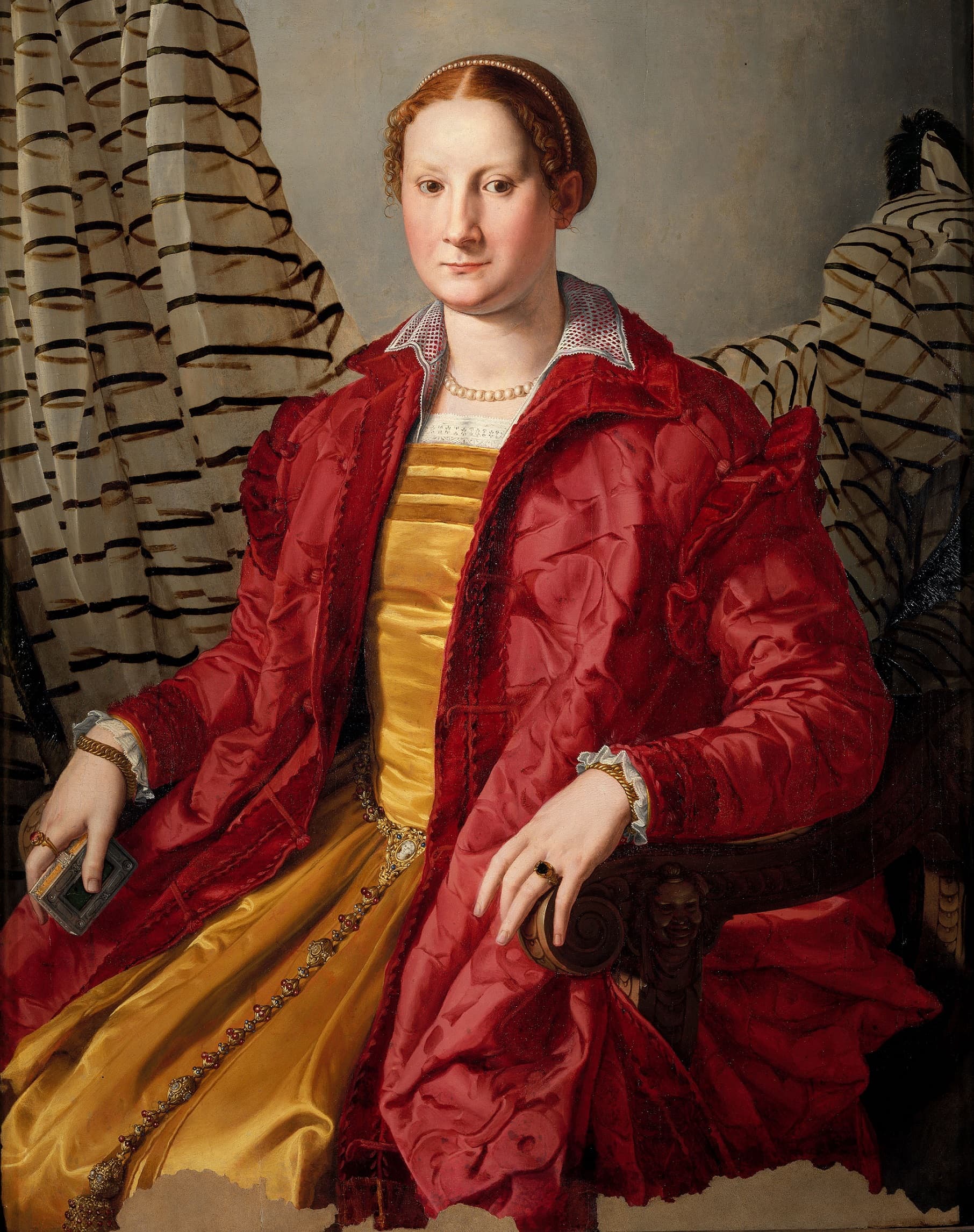
Bronzino (Agnolo di Cosimo di Mariano), Italian, Monticelli 1503–1572, Florence, Portrait of a Woman (probably Cassandra Bandini) ca. 1550–55, Oil on panel, Galleria Sabauda, Turin, Image: Scala / Art Resource, NY 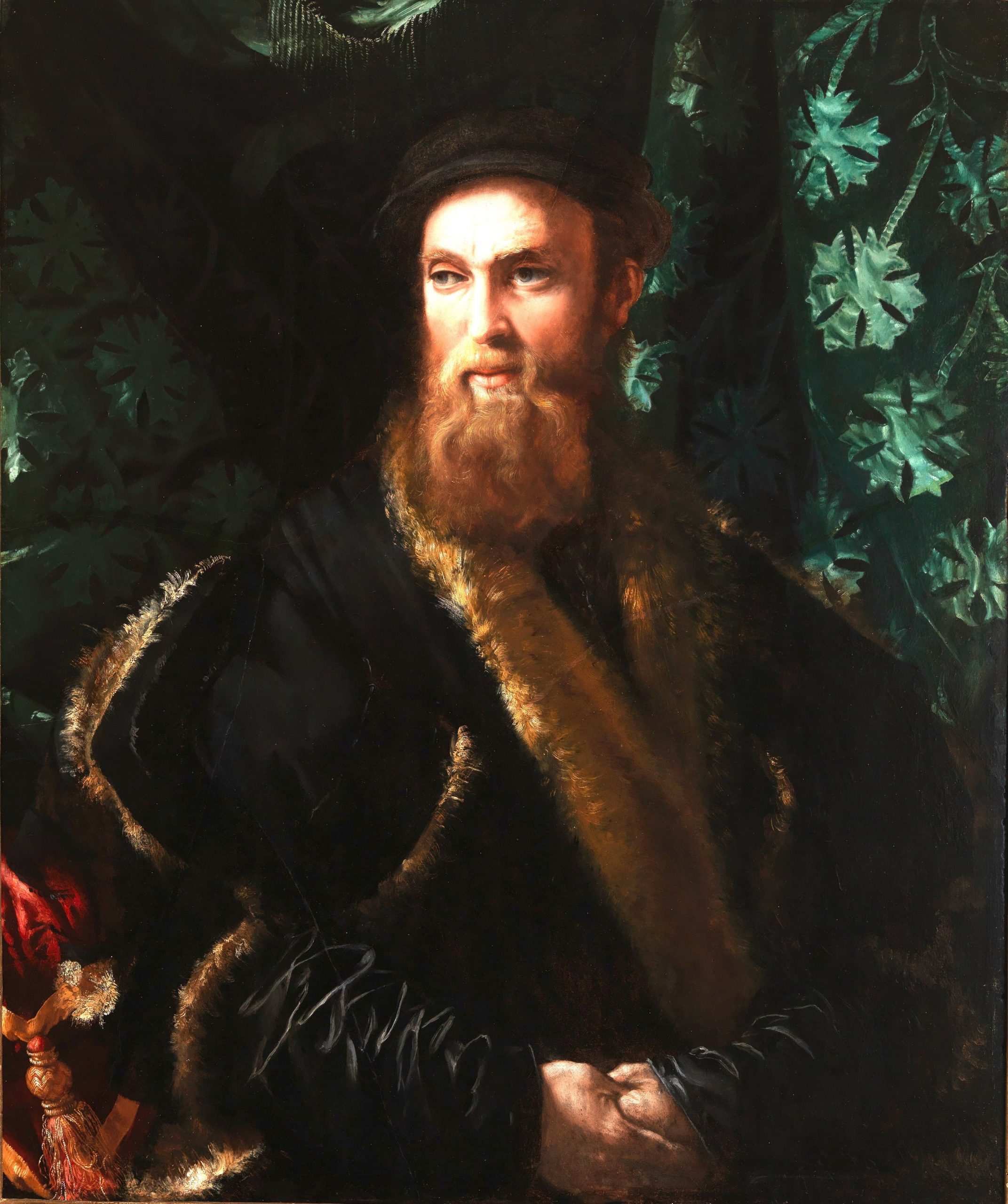
Francesco Salviati (Francesco de’ Rossi), Italian, Florence 1510–1563 Rome, Bindo Altoviti, ca. 1545. Oil on marble, Private Collection, Photograph © Bruce M. White, 2020
The tradition of black and dark-colored clothing in Florentine male portraiture had no rival in other parts of Italy or elsewhere in Europe. At this Met show, the inclusion of the Francesco Salviati portrait of Bindo Altoviti around 1545 served as a stylistic contrast between Rome and Florence court and aristocratic menswear in other capitals like Rome where the menswear had more decorations like furs.
In addition, children seemed exempt from black garments like the portrait of the young Francesco de’Medici and his mother Eleonora di Toledo. The young son of the Duke wore a shiny red silk doublet with elaborate gold braids passementerie trims. In another Bronzino painting in 1551, Francesco was solo in a rich deep wine velvet doublet with carved leather stripes. His younger brother Garcia wore a red-gold silk doublet with a collar embroidered in white pearls.
(Images left to right: Bronzino (Agnolo di Cosimo di Mariano), Italian, Monticelli 1503–1572 Florence and workshop Eleonora di Toledo and Francesco de’ Medici ca. 1550. Oil on panel, Museo Nazionale di Palazzo Reale, Pisa Image © Haltadefinizione® Image Bank by permission of the Ministry of Cultural Activities and Heritage— Polo Museale della Toscana. Bronzino (Agnolo di Cosimo di Mariano), Italian, Monticelli 1503–1572 Florence. Francesco de’ Medici, ca. 1551. Oil on panel, Galleria degli Uffizi, Florence. Bronzino (Agnolo di Cosimo di Mariano), Italian, Monticelli 1503–1572, Florence Garzía de’ Medici, ca. 1550. Oil on panel, Museo Nacional del Prado, Madrid Image: ©Photographic Archive, Museo Nacional del Prado, Madrid.
Florentine noblemen under Cosimo I wore black as the color of power and authority, whereby anything colors, ribbons, bows, stripes, or lacing might be reserved solely for special festivities. Black clothes reflected manhood in this male-dominated city-state. The male dressing was thus performance, and the clothes gave the wearer a form.
Men’s couture fashion was always at the center of Bronzino and Pontormo painted portraitures. These portraits at the Met are a document of this particular epoch, anchored by the individuals and the fashion they wore as sitters to convey ideology and power convincingly. Fashion was the apparatchiks solidifying the male ideals for social, sexual, and political standings and the more ingrained spectrum of idealized virtues in the short period of the transformation of Florence from a republic to a ducal state.
The Medicis were significantly invested in their physical appearances to solidify social hierarchy and class boundaries. Their specific portrait fashion formalized a standard of look. These Medici portraits were also drawn for other men, nobles from other principalities, looking at these Florentine noblemen as models of how politicians should appear to the public and each other.
Haute couture today depends on the skills of the artisans inside the atelier of the fashion houses or at the specialized skills artisanal firms like Lesage, Montex, and Maison Michel. Then the creations of these sumptuous and refined clothes worn as symbols of identification and authority required a host of skilled tailors, fabrics makers, embroiderers, dress-makers, and leather experts, each contributing to specific garment-making areas according to their knowhow.
Portrait painting is the context of costume, political, social, economic, gender, and class history, all contained within these frames. The haute couture fashion was not just the clothes but also incorporated into the painted portraits’ posed gestures. The hands-on-hips or grabbing a book, the standing pose, and the location background all ingrained into how the sitter dressed, the fabrics’ textures, the cuts of the specific coat, and the trimming indicated status. Men’s haute couture clothes served as the definite non-verbal statement of political, economic, and social power.
The haute couture fashion details in these portraits are the only surviving visual cues as to the Medici’s contemporaneous importance on their wardrobe choice for these sittings. Only the rare funeral garments of the Grand Duke Cosimo I de’ Medici, his wife Eleonora da Toledo and their son Garcia de’ Medici restored and on display at the Pallazzina della Meridiana at the Pallazo Pitti in Florence. These portraits remained the sole testimony of cultural-social-political-economic documentation of the actors at the moment in the rise of Florence, the capital of the Italian Renaissance.
Five centuries later, in a very different world, fashion still plays this principle role of defining status, power, identity, class, gender, and many more. Instead of singular portraits of paint of the principal leaders of the society, we have millions and millions of selfies taken daily of the everyday person posting on their social media in their attempts to identify themselves to their peers and their tribes. The medium and the media have changed, but the role of fashion endures, now as then.
